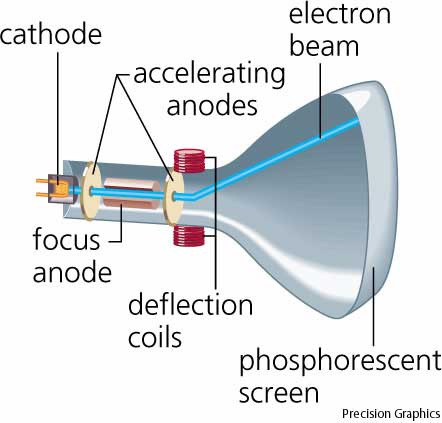
In 1982, Sony was the first brand to mass-produced pocket television - Sony Watchman FD-210. Back in 1936, BCC began to transmit world’s first analog high definition television 405 line television broadcasting from the Victorian Alexandra Palace (London), which is considered as the birth place of broadcasting.
#Cathode ray tube tv tv#
Their research led to the presence of liquid crystals in optical imaging devices, technology still used today.Īnalog High definition television actually started in 1936!Īlthough the quality wasn’t that superior compared to today’s high definition TV it was certainly a revolutionary. Later, in 1960, James Fergason and two colleagues from Westinghouse Electric Corporation proved that a film of liquid crystals exhibited different temperature patterns on the skin. He further even observed and concluded that this substances not only has two melting points but, it reflected polarized light and could rotate the polarization direction of light. And, when it reached 179 degree Celsius it changed again, but into a clear liquid this time. In 1888, an Austrian botanist Friedrich Reinitzer while studying cholesteryl benzoate of carrots observed that when heated cholesteryl benzoate initially at 145 degree Celsius it melted and turned into cloudy fluid. Liquid Crystals were accidentally discovered while studying Carrots This screen would emit a visible light when struck by a beam of electrons. Braun introduced a CRT with a fluorescent screen, known as the cathode ray oscilloscope. Image courtesy: CRT TV’s (Cathode- Ray Tube) a.k.a Picture Tubeĭon’t you recollect your childhood when you hear of CRT TV’s? But do you know, when was it invented and by whom? The first cathode ray tube scanning device was invented by the German scientist Karl Ferdinand Braun in 1897. Hundreds of stations experimented with television broadcasting using the Nipkow system in the 1920s and 1930s, until it was replaced by all-electronic systems in the 1940s. The first black and white transmission was created by the famous German inventor Paul Nipkow invented the Nipkow disk in 1884, one of the first successful technologies for television transmission. John Logie Barid was the first person to create live pictures and is considered to be the brains behind successfully designing and developing the television. Thankfully, we are still here to help if you have any questions.Although, there were many pioneers like Leon Theremin, Philo Farnsworth, Charles Francis Jenkins, William Bell Boris Rosing and Vladimir Zworkin who designed and developed TV.


It doesn’t “give a little” like a flat-screen plasma would.

And if you’ve ever wanted to learn about how a CRT actually works, check out the How Stuff Works post about them. While virtually no one in the United States buys CRTs anymore, CRTs still make up a significant amount (often over 60%) of what we collect at electronics recycling events. These require special handling, which is a service we have to pay for (requiring us to pass on that charge to you). Typical CRT TVs or monitors each contain 4-8 pounds of lead in the glass tube, and the inside of the tubes get coated with toxic phosphor dust.

While many don’t realize, inside that clunky glass tube is lead, mercury, and many other toxins that need to be handled properly. We never want to surprise a customer with sticker shock at time of drop-off. The reason we ask is that those tube-style, also known as CRT (Cathode Ray Tube), are very difficult to responsibly recycle and therefore we need to charge accordingly. When a lovely voice asks if we recycle TVs, our next question is if it’s one of those old tube-style with the clunky glass front or if it’s the newer flat panel. There isn’t a day that Repowered doesn’t receive a call asking about TV recycling.


 0 kommentar(er)
0 kommentar(er)
